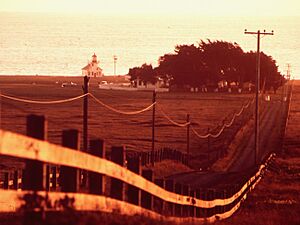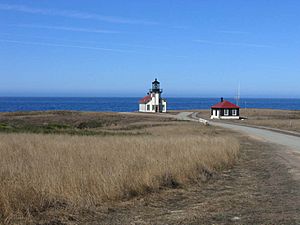Point Cabrillo Light facts for kids
| Location | Caspar California United States |
|---|---|
| Coordinates | 39°20′54.97″N 123°49′34.02″W / 39.3486028°N 123.8261167°W |
| Year first constructed | 1909 |
| Automated | 1973 |
| Foundation | concrete base |
| Construction | wooden tower |
| Tower shape | octagonal tower with balcony and lantern on fog signal building |
| Markings / pattern | white tower, black lantern |
| Height | 47 feet (14 m) |
| Focal height | 81 feet (25 m) |
| Original lens | Third-order Fresnel lens |
| Range | 22 nautical miles (41 km; 25 mi) |
| Characteristic | Fl W 10s. |
The Point Cabrillo Light is a famous lighthouse in northern California, United States. It stands between two other points, Point Arena and Cape Mendocino. This lighthouse is just south of a small town called Caspar.
Since 1909, it has been a special helper for ships, guiding them safely along the coast. Today, it is part of a state park called Point Cabrillo Light Station State Historic Park.
It's important not to mix up this lighthouse with others in San Diego. Those are the Old Point Loma Lighthouse and the New Point Loma Lighthouse. They are both inside Cabrillo National Monument and sometimes get called "Cabrillo lighthouses" too.
Contents
Discovering Point Cabrillo Lighthouse
The Point Cabrillo Lighthouse is about 1.5 miles north of Mendocino, California. It's not just the lighthouse building; there are other old buildings around it. Most of these original structures are still there today.
Sadly, the old barn is gone. It was accidentally destroyed in a fire department exercise in 1986. Even without the barn, this lighthouse station is known as one of the most complete in the United States.
How the Lighthouse Shines Brightly
At the very top of the lighthouse, there's a special Fresnel lens that spins. This lens has four panels with 90 lead glass prisms. It's very heavy, weighing 6,800 pounds! An English company called Chance Brothers made it. They shipped it all the way to Point Cabrillo by sailing around Cape Horn.
The light itself is only 32 feet above the ground. But because the land it sits on is so high, the light shines 81 feet above sea level. When it was first built, a kerosene lamp lit the way. A clockwork system, like a giant clock, made it turn. In 1935, electricity took over, with an electric light and motor.
Today, the light uses a single 1000-watt electric bulb. The Fresnel lens focuses this light into a powerful beam. This beam can be seen far out at sea, even beyond the horizon. The beam spins once every 40 seconds, making a flash appear every 10 seconds.
A Look Back in Time: History of Point Cabrillo
Point Cabrillo is a rocky piece of land made of sandstone. It got its name in 1870 from the United States Geological Survey. They named it after a Portuguese explorer named João Rodrigues Cabrilho. He explored the California coast for Spain, but his journey didn't reach this far north.
Early Shipwrecks and the Need for a Light
In 1850, a ship called the Frolic crashed on a reef north of Point Cabrillo. When people investigated the wreck, they discovered the huge coast redwood forests nearby. This discovery started the timber trade, which became very important for the local economy.
In 1873, people thought about building a lighthouse here. But it didn't happen right away. After several more shipwrecks, the U.S. Lighthouse Service finally said in 1904 that a lighthouse was needed.
Building the Lighthouse
A bill to pay for the lighthouse passed in June 1906. The government bought 30 acres of land from a rancher for $3,195. The Lindgren Company started building the lighthouse in 1908. It began helping ships in 1909. Wilhelm Baumgartner was the first light keeper, working there until 1923. In 1935, a very loud foghorn was added.
The United States Coast Guard took over the Lighthouse Service in 1939. In 1960, a big storm caused waves to crash over the lighthouse. Mud flooded the building, but the important lens stayed safe. Later, during the Cold War, the station was used for training. It pretended to be a Soviet radar base.
The Coast Guard kept people at the station until 1973. Then, the old lens was covered, and a new, modern light was put on the roof.
Bringing the Lighthouse Back to Life
In 1988, the California Coastal Conservancy started buying the land around the lighthouse. In 1991, the station was added to the National Register of Historic Places. This means it's a special place worth protecting.
However, the California State Park System couldn't take over the land then. So, a non-profit group called the North Coast Interpretive Association managed it for nine years. Starting in 1996, this group worked hard to restore the station. They wanted it to look just like it did in the 1930s, after it got electricity. They even brought the main lens back into use!
In 1999, the original Fresnel lens was put back after being updated. It had to be as reliable as lights used at airports. The restored lighthouse opened to the public in August 2001. It even appeared in a movie called The Majestic that same year.
In 2002, California State Parks bought the light station for four million dollars. The non-profit group then became the Point Cabrillo Light Keeper Association. They still run the station for the state park system today. The U.S. Coast Guard recognizes the light as an official guide for ships. The USCG Auxiliary helps keep it working.
The station won two awards in 2007: the Governor's Historic Preservation Award and the Preservation Design Award.
Exploring the Area
In 2011, a hiking trail was created. It's part of the California Coastal Trail. This trail connects the lighthouse station to Caspar Headlands State Beach, which is one mile north. Along the way, you can see Frolic Cove, named after the shipwreck.
See also
- List of lighthouses in the United States
- List of Museums in the North Coast (California)



